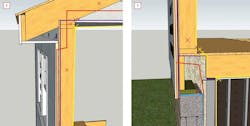Eliminating Building Envelope Confusion: X Marks the Spot
The Right Question
The focus on energy efficiency often centers around how much insulation we need, but that question reduces treatment of the building envelope to a calculation of the depth of the stud bays. As our Minnesota carpenter showed us, however, other factors, such as air movement and moisture, are in play.
How much insulation do you need? Probably more than you have but less than you think you need. It’s the wrong question—or more accurately, it shouldn’t be the first question. Instead, we should focus on determining “continuous insulation value,” which considers all of the factors affecting the building envelope.
Here’s a simple tool that will allow you to identify 99 percent of potential envelope problems in any project. Get four pens in four colors. Now take out the plans and, without lifting the pens from the paper, see if you can draw an uninterrupted line around the structure to mark each of these four control layers:
- Thermal (red)
- Water—drainage plane and capillary breaks (blue)
- Air (purple)
- Vapor (yellow)
Work with 3-D views [1, main image] as well as floor plans and sections through walls, floors, and roofs [2 & 3, above] to visualize tricky intersections. Wherever your pen encounters an obstacle, make an “X” on the paper—those are the problem spots. The more X’s you have, the more lipstick you will need for that pig.
Remember the following:
- Insulation gets a red X every time it’s interrupted by a framing member.
- Concrete is porous and is a poor insulator.
- Everywhere two pieces of wood touch each other gets a purple X for air sealing.
- Anytime a pipe, duct, or wire travels through a framing member, passes from one floor to the next, or crosses a thermal plane, it gets three X’s, one each for the air, thermal, and vapor control layers.
---
Michael Anschel is president of Otogawa-Anschel Design+Build in Minneapolis, and a founding board member of Greenstar.

